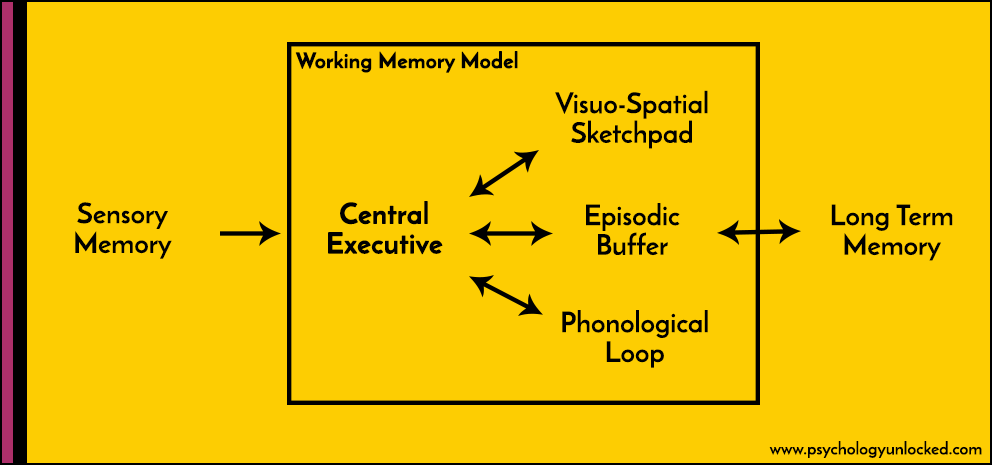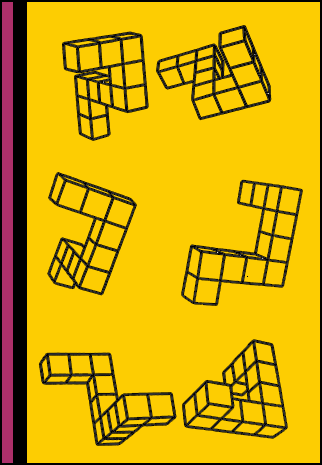QUICK READ
In 1974, Baddeley & Hitch presented the Working Memory model – a new theory of primary memory, which distinguished itself from previous theories by splitting up the memory store into multiple components.
The Working Memory Model divides primary memory into the following parts:
The Central Executive
A core, supervisory module. The Central Executive controls the flow of information to and from the various slave systems and conscious thought.
The Visuo-Spatial Sketchpad
Split into two parts, the Visuo-Spatial sketchpad is responsible for visual information. For example recalling a journey, or picturing a scene. The Visual Cache interprets information about colour and form (something of an inner eye), and the Inner Scribe arranges visual information in the ‘mind’s eye’.
The Phonological Loop
This element of Working Memory is responsible for auditory and semantic information. The Phonological Store operates as an inner ear, whilst the Articulatory Process rehearses words to keep them in Working Memory whilst required.
The Episodic Buffer
Not much is known about the Episodic Buffer, but it is assumed that Working Memory must have an interaction with Long Term Memory, and so the Episodic Buffer has been included in the model to represent this function.
Baddeley & Hitch’s model has been repeatedly tested and developed over the last few decades and remains the leading theory of primary memory. The model receives empirical support from dual-task studies as well as brain-damage case studies, such as KF.
DETAILED EXPLANATION
Perhaps the first thing to note about Working Memory is that it is a development on the understanding of Short Term Memory, or Primary Memory.
Because Short Term Memory contains both new information from the outside world and ‘old’ information retrieved from Long Term Memory, Baddeley & Hitch (1974) led the way in using the term Working Memory to add clarity.
Working Memory ‘represents our ability to remember what we have just perceived and to think about it in terms of what we already know’ (Martin, Carlson & Buskist, 2007).
Support for a Working Memory model of primary memory comes from an individual’s ability to multi-task – something that would surely be impossible if primary memory were a single, unified store.
The cognitive structure of Working Memory has been developed by investigating which tasks can (and which cannot) be easily completed simultaneously. The assumption being that if two tasks can be completed at the same time, with no loss of efficiency, then they must be utilising different elements of working memory.
Baddeley & Hitch’s (1974) Working Memory model is comprised of three components: the Central Executive, Phonological Loop and Visuo-Spatial Sketchpad.
The Central Executive
Despite its grand title, not a huge amount is known about the Central Executive. It was first included in the model due to a perceived requirement for a supervisory function, which would be able to channel information to and from the slave systems (see below).
Baddeley (1986) proposes that the Central Executive allocates mental resources to working memory tasks and supervises the updating of what is in working memory at any given moment.
Daneman & Carpenter’s (1980) Reading Span Task research measures how flexibly we can allocate mental resources to the processing and storing of material. Participants were required to read sentences whilst (a) verifying the truthfulness of the sentence and (b) remembering the final word of each sentence. If an individual is a good reader, reading the sentence to determine the truthfulness of the statement will use up very few cognitive resources, leaving more resources available in working memory to recall the final word of each sentence. However, weaker readers who require a greater cognitive effort to comprehend the sentence have fewer resources available for the second task of recalling the final word. This experiment hints at an active role of the central executive at divvying up the cognitive resources required to complete tasks.
Overall, little research has been conducted on this element of the model, and therefore its inclusion is more due to the assumption that it logically exists than experimental proof of its existence.
The Phonological Loop
In 1974, Baddeley & Hitch theorised about an Articulatory Loop. Over time this has been replaced by what is now termed the Phonological Loop. The Phonological Loop can be sub-divided into two processes:
- the Phonological Store – nicknamed the Inner Ear
- the Articulatory Process – nicknamed the Inner Voice
As the name suggests, the phonological loop allows the retention of verbal phonetic information and the interaction between the phonological store and articulatory process is akin to a cassette tape, hence the ‘loop’.
By reading this article you are, in fact, exercising your phonological working memory. Whether you are reading out loud or silently, you are saying the words as you read them. If reading silently to yourself, the articulation process (inner voice) is activated. Information regarding this activity is communicated to circuits of neurons in the auditory system, which subsequently allows the words to be ‘heard’ (inner ear). The information is then looped back to the articulatory system, which silently repeats the word. This loop continues until the individual’s attention turns to something else or it is replaced with new information.
According to Baddeley et al. (1975), the capacity of the Phonological Loop is determined by how much information an individual is able to rehearse in a two second period.

The Visuo-Spatial Sketchpad
A lot of the information we process is non-verbal, and this information is served by the Visuo-Spatial Sketchpad. As with the Phonological Loop, the Visuo-Spatial Sketchpad can be broken down into two sub-systems:
- the Visual Cache – stores information about form and colour
- the Inner Scribe – arranges objects in the visual field

For example, if you were to look out of your window and then close your eyes you would be able to imagine the scene in your mind’s eye. You may also be able to visualise a journey you take regularly, or recall your favourite painting in a gallery you’ve visited. All of these tasks involve an interaction between the visual cache, inner scribe and central executive, which returns the memory to your conscious attention.
A classic study of visual working memory was conducted by Shepard & Metzler (1971). They asked participants to complete a mental rotation task. Participants had to say whether two drawings of three-dimensional cube structures were the same structure or different structures (see picture to the right). The researchers found that people are able to accurately recognise when the pairs of shapes matched. However, participants took longer to work this out if one of the drawings had been rotated, so as to show the structure from a different angle. This exercise demonstrates the role of visual working memory in recognising objects (the visual cache) as well as mentally manipulating an object to decide whether two objects are the same (viewed from different angles) or different; making use of the inner scribe.
How Does Working Memory Work?
So far we have outlined the component parts of the working memory and provided some experimental evidence to support their role in the model. It is worth briefly considering the model, not as its constituent parts but as a complete function.
The favoured view of working memory is the ‘resource sharing model’ proposed by Daneman & Carpenter (1980, see Central Executive) – though it was not referred to as the resource sharing model until 2001 – which suggests cognitive resources are divided between tasks, which compete for the attention and resources of working memory.
A large body of dual-task studies provide evidence supporting this model. Completing two tasks that compete for the same resource at the same time leads to a decrease in efficiency in both tasks. However, simultaneously completing two tasks, which make use of different components of working memory (for example, a verbal task and a visual task) does not negatively affect a person’s ability to efficiently and accurately complete either task.
The case study of KF (Shallice & Warrington, 1970) – an individual who suffered brain damage as a result of a motorbike accident – provides evidence that the different slave systems within working memory are situated in different areas of the brain, and are therefore anatomically separate as well as cognitively distinct. KF suffered impairments in verbal information, but his memory for visual information was largely unaffected following the motorbike accident. Case studies, of course, may lack external validity as they are unable to assess whether it is possible to generalise the results of a specific case to a wider population.
